Cryptocurrency investing intimidates many potential investors. The technical jargon, overwhelming number of tokens, security concerns, and stories of people losing fortunes create paralysis. You know crypto represents an opportunity, but where do you even begin?
Token Metrics AI Indices eliminate these barriers by providing a simple, secure pathway into cryptocurrency investing. Whether you've never bought crypto before or you're transitioning from traditional investments, this comprehensive beginner's guide walks you through everything needed to start investing successfully in just 30 minutes.
No technical expertise required. No complicated wallet setup. No endless research into thousands of tokens. Just straightforward steps that get you invested intelligently and positioned for long-term wealth creation.
What Exactly Are Crypto Indices? (Explained Simply)
Before diving into the how-to, let's establish a simple understanding of what you're investing in.
Think of crypto indices like a basket containing multiple cryptocurrencies. Instead of buying Bitcoin or Ethereum individually, you buy a pre-made collection of several carefully selected digital assets. This is similar to how traditional stock index funds like the S&P 500 contain hundreds of companies rather than forcing you to pick individual stocks.
Token Metrics creates these baskets using artificial intelligence that analyzes thousands of cryptocurrencies and selects the best ones based on comprehensive data. The AI acts like a team of expert analysts working 24/7, constantly monitoring market conditions and adjusting your portfolio to maximize returns while managing risk.
When you invest in a Token Metrics index, you're essentially hiring sophisticated AI technology to build and manage your crypto portfolio professionally. You get instant diversification across multiple tokens, automatic rebalancing when market conditions change, protection from common investing mistakes, and access to opportunities you'd never find independently.
The beauty of this approach is simplicity. You don't need to understand blockchain technology, read complicated whitepapers, or analyze trading charts. The AI handles complexity while you focus on your life and watch your investment grow.
Why Beginners Should Start with Indices Instead of Individual Tokens
- New investors often make the mistake of buying individual cryptocurrencies based on social media hype, friend recommendations, or price momentum. This approach leads to several problems that indices elegantly solve.
- Individual token selection requires expertise most beginners lack. How do you evaluate whether a cryptocurrency's technology is legitimate or vaporware? How do you determine if tokenomics are sustainable? How do you identify scams before they steal your money? Without experience, these questions prove nearly impossible to answer correctly.
- Concentration risk destroys portfolios quickly. If you invest everything in three tokens and one fails catastrophically, you lose a third of your capital immediately. Indices spread risk across 10-30 carefully vetted assets, ensuring single failures don't devastate your portfolio.
- Emotional decision-making causes most investment losses. Fear drives panic selling during downturns. Greed drives buying at market tops. FOMO drives chasing pumps into overvalued assets. AI indices eliminate emotion entirely, maintaining discipline when human investors make terrible decisions.
- Time requirements prove unsustainable. Successfully managing individual crypto positions requires hours daily monitoring markets, reading news, analyzing charts, and executing trades. Most people with jobs and families can't sustain this commitment. Indices require maybe 30 minutes quarterly.
For beginners, indices provide the perfect entry point—immediate diversification, professional management, emotion-free investing, and minimal time commitment. You can start small, learn gradually, and scale up as you become comfortable.
Step-by-Step: Your First 30 Minutes in Crypto Indices
Ready to begin? Follow this simple roadmap to go from complete beginner to invested in under 30 minutes.
- Minutes 1-5: Create Your Token Metrics Account
- Visit the Token Metrics website and click the sign-up button. You'll need to provide basic information including email address, create a secure password, and verify your email through the confirmation link sent to your inbox.
- Token Metrics offers a 7-day free trial, allowing you to explore the platform thoroughly before committing financially. Take advantage of this trial to familiarize yourself with available indices, review performance data, and understand the interface.
- During signup, you'll choose a subscription tier. For beginners, start with the basic tier that provides access to all indices and essential features. You can upgrade later if you want additional tools like advanced analytics or trading signals.
- Minutes 6-15: Explore Available Indices and Choose Your Strategy
- Once logged in, navigate to the Indices section. You'll see several different index options, each designed for specific investment strategies and risk profiles. Here's how to choose:
- Conservative Investor Grade Index: If you're risk-averse, older, or investing money you can't afford to lose, start here. This index focuses on established cryptocurrencies with strong fundamentals—primarily Bitcoin, Ethereum, and select large-cap altcoins. Returns are more moderate but volatility is lower.
- Balanced Growth Index: If you're comfortable with moderate risk and seeking steady growth, this balanced approach combines major cryptocurrencies with promising mid-cap projects. It offers stronger growth potential than conservative indices while maintaining reasonable risk levels.
- Aggressive Growth Index: If you're young, risk-tolerant, and seeking maximum returns, this index targets smaller-cap tokens with explosive potential. Volatility is higher but so are potential returns. Only choose this if you can stomach significant price swings.
- Sector-Specific Indices: Token Metrics offers indices focused on specific crypto sectors like DeFi, Layer-1 blockchains, AI tokens, or memecoins. Choose these if you believe strongly in a particular sector's growth potential.
- For most beginners, starting with the Balanced Growth Index makes sense. It provides diversification, reasonable growth potential, and manageable volatility. You can always adjust later as you learn more.
- Minutes 16-20: Determine Your Investment Amount
- How much should you invest in crypto indices? This critical decision depends on your financial situation, but follow these general guidelines.
- Never invest money you need for living expenses. Crypto remains volatile. Only invest money you won't need for at least 3-5 years and that you could lose entirely without affecting your lifestyle.
- Start small while learning. If you're completely new to crypto, consider investing just $500-1,000 initially. Get comfortable with the process, experience some market volatility, and understand how indices work before committing larger amounts.
- Follow the 5-20% rule. Financial advisors typically recommend allocating 5-20% of your total investment portfolio to cryptocurrency depending on age and risk tolerance. If you have $50,000 in traditional investments, consider $2,500-10,000 in crypto.
- Use dollar-cost averaging. Rather than investing your entire amount immediately, spread purchases over 3-6 months. If you plan to invest $6,000, invest $1,000 monthly. This reduces timing risk and smooths out entry prices.
- Write down your investment amount now so you don't invest emotionally based on market conditions. Stick to your predetermined plan regardless of whether markets are surging or crashing.
- Minutes 21-25: Set Up Your Exchange Account and Funding
- To invest in Token Metrics indices, you need to purchase the recommended cryptocurrencies through a cryptocurrency exchange. Major exchanges include Coinbase, Kraken, Binance.US, or Gemini.
- Choose one exchange and create an account. You'll need to provide identification for regulatory compliance—typically a driver's license or passport. This verification process usually takes a few hours to a few days, so you might need to pause here and return once approved.
- Once verified, connect a funding source. Most beginners use bank transfers, though credit cards and debit cards work too (often with higher fees). Transfer funds from your bank account to your exchange account. Bank transfers typically take 1-3 business days but have lower fees than card payments.
- For security, enable two-factor authentication (2FA) on your exchange account immediately. This adds an extra security layer requiring a code from your phone when logging in, protecting against unauthorized access.
- Minutes 26-30: Make Your First Index-Aligned Purchases
- Now comes the exciting part—your first crypto investments. Token Metrics indices provide specific recommendations about which tokens to buy and in what proportions.
- Review your chosen index's current composition. It might show something like: 40% Bitcoin, 25% Ethereum, 15% Solana, 10% Avalanche, 10% Polkadot. These percentages tell you how to allocate your investment.
- If investing $1,000, you'd buy approximately $400 in Bitcoin, $250 in Ethereum, $150 in Solana, $100 in Avalanche, and $100 in Polkadot. Round to reasonable amounts given minimum purchase requirements.
- On your exchange, navigate to each cryptocurrency and execute market buy orders. A market order purchases at current market price immediately. For beginners, market orders are simplest—don't worry about limit orders or advanced trading features initially.
- After purchasing, you can either leave assets on the exchange (simplest for beginners with small amounts) or transfer to a personal wallet (more secure for larger holdings). Initially, leaving assets on a reputable exchange is fine. Learn about wallet security as your investment grows.
- Congratulations! You're now invested in crypto indices. The entire process took under 30 minutes.
Understanding What Happens Next: Ongoing Management
After your initial investment, understanding ongoing management helps you stay invested successfully.
Token Metrics indices rebalance regularly as market conditions change. You'll receive notifications when adjustments are recommended. These typically occur weekly, bi-weekly, or monthly. Follow the recommendations by making small adjustments—usually just a few minutes to execute.
Check your portfolio monthly rather than daily. Cryptocurrency volatility means dramatic day-to-day swings. Monthly reviews allow tracking overall trajectory without getting caught up in noise. Token Metrics provides performance tracking tools showing returns over various periods and comparing to benchmarks.
Occasionally rebalance your overall portfolio allocation. If crypto has grown from 10% to 25% of your total investments, consider taking profits to rebalance back to your target. This ensures you don't become overexposed during market euphoria.
Common Beginner Questions Answered
New investors often have the same questions and concerns. Here are straightforward answers.
"Is crypto investing safe?"
Cryptocurrency carries risk like all investments. However, indices are far safer than buying random tokens. Token Metrics' AI vetting filters out scams, diversification reduces risk, and professional management protects against emotional mistakes.
"What if I lose everything?"
This is why you only invest money you can afford to lose. Crypto indices are diversified across multiple assets, making total loss extremely unlikely. Individual tokens can fail, but portfolios of 10-30 carefully selected tokens provide resilience.
"How much can I make?"
Token Metrics indices have historically delivered returns significantly exceeding Bitcoin and Ethereum. Conservative indices might return 100-200% annually during bull markets. Aggressive indices could deliver 300-500%+. Bear markets may see negative returns—long-term holding is essential.
"What about taxes?"
Cryptocurrency transactions trigger capital gains taxes in most jurisdictions. Keep records of all transactions. Token Metrics provides transaction tracking to simplify tax preparation. Consult a tax professional for personalized guidance.
"Do I need a special wallet?"
For beginners with smaller amounts, keeping crypto on a reputable exchange is acceptable. As holdings grow beyond $10,000, consider a hardware wallet for additional security.
"Can I start with just $100?"
Yes! While larger amounts generate more absolute returns, you can start with any amount. Use small initial investments to learn and build confidence.
Your 30-Day Action Plan for Success
- Days 1-7: Leave your investment alone. Resist checking prices constantly. Use this week to explore Token Metrics' educational resources and learn about the cryptocurrencies in your index.
- Days 8-14: Conduct your first performance review. Don't react emotionally to gains or losses. Review any rebalancing recommendations and execute them if suggested.
- Days 15-21: Evaluate whether your initial allocation feels appropriate. If you chose dollar-cost averaging, make your second purchase following your predetermined schedule.
- Days 22-30: Reflect on your first month. Did you stay calm during volatility? Are you confident in your strategy? Decide whether to continue your current approach or make adjustments.
After 30 days, continue monthly reviews, execute recommended rebalancing, and stick to your dollar-cost averaging schedule. Successful investing is about consistency and discipline, not constant activity.
Conclusion: Your Journey Begins Now
Cryptocurrency investing doesn't require technical expertise, complicated processes, or endless time commitment. Token Metrics AI Indices make professional-grade crypto investing accessible to anyone willing to follow a simple, proven system.
You've learned what indices are, why they're perfect for beginners, and exactly how to get started in 30 minutes. You understand ongoing management, have answers to common concerns, and possess a 30-day action plan for success.
The only thing remaining is action. Every day you delay is a day you're not participating in one of the most significant wealth creation opportunities of our generation. Markets don't wait for perfect timing—they reward those who begin with imperfect action.
Your 30-minute journey to crypto investing starts with a single click. Sign up for Token Metrics' 7-day free trial today, explore the indices, and make your first investment following this guide. Your future self will thank you for taking action now rather than watching from the sidelines as others build life-changing wealth.
The tools are available. The guidance is clear. The opportunity is now. Begin your Token Metrics journey today.



.svg)


.png)




%201.svg)
%201.svg)


%201.svg)





















.svg)




.png)